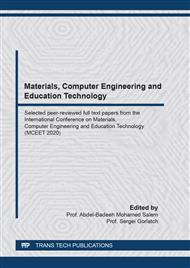[1]
T. Radu, D. Diamond, Comparison of soil pollution concentrations determined using AAS and portable XRF techniques. Journal of Hazardous Materials, 2009,171(1-3), 1168-1171.
DOI: 10.1016/j.jhazmat.2009.06.062
Google Scholar
[2]
L. Fusheng, R.P. Gardner, Implementation of the elemental library stratified sampling technique on the GUI-based Monte Carlo library least squares (MCLLS) approach for EDXRF analysis. Applied radiation and isotopes, 70(7), 2012, 1243-1249.
DOI: 10.1016/j.apradiso.2011.09.012
Google Scholar
[3]
B. Yan, Z. Biliang, Evaluation of uncertainty in measurement of total sulfur content in petroleum products by energy dispersion X-ray fluorescence spectrometry. Chemical Engineering of Oil & Gas / Shi You Yu Tian Ran Qi Hua Gong, 2019, 48(6), pp.83-89.
Google Scholar
[4]
J.H. Liang, P.P. Liu, Z. Chen, G.X. Sun, H. Li, 2018 Rapid evaluation of arsenic contamination in paddy soils using field portable X-ray fluorescence spectrometry. Journal of Environmental ences, 64(002) 345-351.
DOI: 10.1016/j.jes.2017.11.020
Google Scholar
[5]
J.A. Stankey, C. Akbulut, J.E. Romero, et al, Evaluation of X-ray fluorescence spectroscopy as a method for the rapid and direct determination of sodium in cheese. Journal of Dairy ence, 2015, 98(8) 5040-5051.
DOI: 10.3168/jds.2014-9055
Google Scholar
[6]
A. Turner, H. Poon, A. Taylor, et al, In situ determination of trace elements in Fucus spp. by field-portable-XRF. ence of The Total Environment, 2017, 593-594 227-235.
DOI: 10.1016/j.scitotenv.2017.03.091
Google Scholar
[7]
C. Feng, G.U. Yi, G.E. Liang-Quan, Z. Jian-Kun, L.I. Meng-Ting, Z. Ning, The Research on Matrix Effect and Correction Technology of Rock Sample in In-Situ Energy Dispersive X-Ray Fluorescence Analysis. Guang pu xue yu guang pu fen xi = Guang pu, 2017, 37(3) 919-923.
Google Scholar
[8]
B. Tanc, M. Kaya, L. Gumus, M. Kumral, Spectral Interferences Manganese (Mn) - Europium (Eu) Lines in X-Ray Fluorescence Spectrometry Spectrum. Egu General Assembly Conference, EGU General Assembly Conference Abstracts. (2016).
Google Scholar
[9]
S. Rui, T. Xian-Guo, L.I. Zhe, L. Ming-Zhe, L. Min, The research of BP network quantitative analysis technology of the full X-Ray spectrum detected by SDD. Chinese Journal of Analysis Laboratory, 2013, 32(01) pp.121-124.
Google Scholar
[10]
K.H. Ghazali, M.F. Mansor, M.M. Mustafa, A. Hussain, Feature Extraction Technique using Discrete Wavelet Transform for Image Classification. Conference on Research and Development, 2008, pp.1-4.
DOI: 10.1109/scored.2007.4451366
Google Scholar
[11]
A. Zuschlag, G. Hahn, Detection Limit of XRF Measurements at Different Synchrotron Radiation Facilities. International Journal of Contemporary Hospitality Management, 2011, 23(3) 344-360.
Google Scholar
[12]
A.F. Jones, J.N. Turner, J.S. Daly, P. Francus, R.J. Edwards, Signal-to-noise ratios, instrument parameters and repeatability of Itrax XRF core scan measurements of floodplain sediments. Quaternary International, 2019, 514(APR.30) 44-54.
DOI: 10.1016/j.quaint.2018.09.006
Google Scholar
[13]
Singh, H. Kumar, Tomar, S.K., Analysis of Multispectral Image Using Discrete Wavelet Transform. Third International Conference on Advanced Computing and Communication Technologies (ACCT), 2013, pp.59-62.
DOI: 10.1109/acct.2013.46
Google Scholar
[14]
Y. Hu, T. Jiang, A. Shen, W. Li, X. Wang, J. Hu, A background elimination method based on wavelet transform for Raman spectra. Chemometrics and Intelligent Laboratory Systems, 2007, 85(1) 94-101.
DOI: 10.1016/j.chemolab.2006.05.004
Google Scholar
[15]
C.M. Galloway, E.C. Le Ru, P.G. Etchegoin, An iterative algorithm for background removal in spectroscopy by wavelet transforms. Applied spectroscopy, 2009, 63(12) pp.1370-1376.
DOI: 10.1366/000370209790108905
Google Scholar
[16]
H. Yaogai, Baseline correction and background elimination using wavelet transforms. Journal of Huazhong University of ence and Technology (Natural ence Edition), 2011, 39(6) 36-40.
Google Scholar
[17]
I.T. Okumus, A New Approach of Image Denoising Based on Discrete Wavelet Transform. 2016 World Symposium on Computer Applications and Research (WSCAR), 2016, pp.36-40.
DOI: 10.1109/wscar.2016.30
Google Scholar
[18]
L. Fang, L. Anxiang, W. Jihua, Modeling of Chromium, Copper, Zinc, Arsenic and Lead Using Portable X-ray Fluorescence Spectrometer Based on Discrete Wavelet Transform. International journal of environmental research and public health, 2017, 14(10) 1163.
DOI: 10.3390/ijerph14101163
Google Scholar


